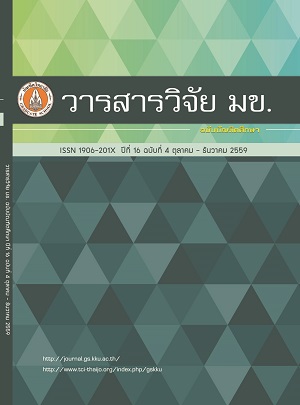การกำจัดสารตะกั่วปนเปื้อนในน้ำเสียสังเคราะห์ โดยใช้เถ้าถ่านลิกไนต์เคลือบเฟอรัสคลอไรด์ (Removing Lead Contamination from Synthetic Wastewater by Using Ferrous Chloride Coated with Lignite Bottom Ash)
Keywords:
การกำจัดตะกั่ว (Lead removal), การดูดซับ (Adsorption), เถ้าถ่านลิกไนต์ที่เคลือบและไม่เคลือบผิวด้วยเฟอรัสคลอไรด์ (Coated and non-coated ferrous chloride with lignite bottom ash)Abstract
งานวิจัยนี้มีวัตถุประสงค์เพื่อศึกษาประสิทธิภาพของการดูดซับตะกั่วจากน้ำเสียสังเคราะห์ โดยใช้เถ้าถ่านลิกไนต์ที่เคลือบและไม่เคลือบผิวด้วยเฟอรัสคลอไรด์เป็นตัวดูดซับ ในน้ำเสียสังเคราะห์มีความเข้มข้นของตะกั่ว 0.896 มิลลิกรัมต่อลิตร ค่าพีเอช 3.7 ศึกษาขนาด พื้นที่ผิว ความสามารถการแลกเปลี่ยนแคทไอออน ความสามารถการดูดซับไอโอดีน ระยะเวลาและพีเอชที่เหมาะสมในการบำบัด รูปแบบไอโซเทอร์ม และประสิทธิภาพการดูดซับในถังปฏิกรณ์แบบ Fluidized Bed พบว่า ประสิทธิภาพการดูดซับตะกั่วดีที่สุดที่ค่าพีเอชเริ่มต้น 5 ทั้งเถ้าถ่านลิกไนต์เคลือบและไม่เคลือบผิวเฟอรัสคลอไรด์ มีประสิทธิภาพ ร้อยละ 97.11 และ 86.37 ตามลำดับ ระยะเวลาที่ประสิทธิภาพการกำจัดตะกั่ว ดีที่สุด คือ 30 นาที เถ้าถ่านลิกไนต์เคลือบและไม่เคลือบเฟอรัสคลอไรด์ ดูดซับได้ร้อยละ 98.37 และ 96.41 ตามลำดับ รูปแบบการดูดซับของเถ้าถ่านลิกไนต์เคลือบและไม่เคลือบเฟอรัสคลอไรด์ สอดคล้องกับสมการ Freundlich จากการศึกษาในถังปฏิกรณ์แบบ Fluidized Bed โดยใช้เถ้าถ่านลิกไนต์เคลือบเฟอรัสคลอไรด์เป็นตัวดูดซับ ความเร็วรอบ 100 รอบต่อนาที อัตราการไหล 150, 200 และ 250 มิลลิลิตรต่อนาที ประสิทธิภาพการกำจัดตะกั่วทั้ง 3 อัตราการไหล ไม่แตกต่างกัน (p-value = 0.083) ที่อัตราการไหล 150, 200 และ 250 มิลลิลิตรต่อนาที ตัวดูดซับเริ่มเสื่อมสภาพ 18, 13 และ 6 ชั่วโมง ตามลำดับ ซึ่งผลการวิจัยนี้จะได้ข้อมูลพื้นฐานในการใช้เถ้าถ่านลิกไนต์ที่เคลือบและไม่เคลือบเฟอรัส คลอไรด์เพื่อเป็นทางเลือกในการพัฒนาตัวดูดซับในการบำบัดน้ำเสียที่มีการปนเปื้อนตะกั่วต่อไป
The aimed of this research was to study the efficiency of lead removal from synthetic wastewater by using adsorption process of coated and non-coated ferrous chloride with lignite bottom ash as adsorbents. The synthetic wastewater containing lead concentration of 0.896 mg/l at pH 3.7 The characteristics of adsorbent were studied includings size, surface area, cation exchange and iodine adsorption capacity. The batch experiment was focus on the proper time, pH and lead adsorption isotherm. The lead removal efficiency of wastewater was studied in the fluidized bed reactor by using coated ferrous chloride bottom ash as an adsorbent. The result from the batch experiment showed that the best lead removal efficiency from coated and non coated with ferrous chloride lignite bottom ash occurred at pH 5. The lead removal efficiency were 97.11% and 86.37%, respectively. The lead removal efficiency of coated and non coated with ferrous chloride lignite bottom ash at the proper duration times of 30 minutes were 98.37% and 96.41%, respectively. Both adsorption isotherm corresponded with Freundlich models. The column fluidized bed reactor was run at 100 rpm. with three different flow rates of 150, 200 and 250 ml/min. The breakthrough times at these flow rates were 18, 13 and 6 hours, respectively. The median of efficiency for 3 flow rates were not statistically significant (p-value = 0.083). The result of this research was served as a background data and an option for development of lignite bottom ash coated and uncoated with ferrous chloride to remove wastewater containing lead.


